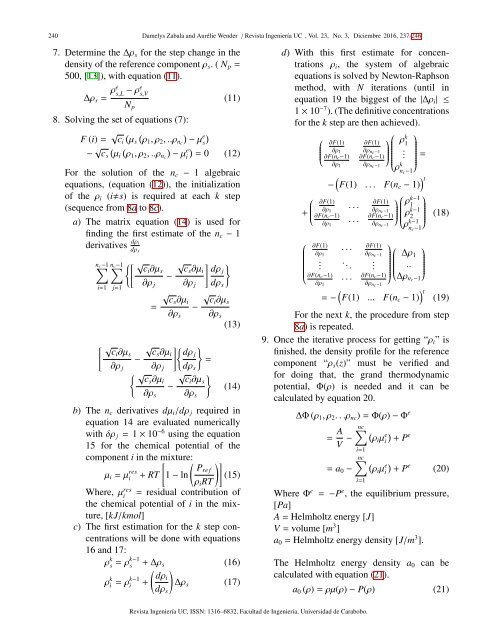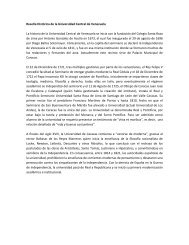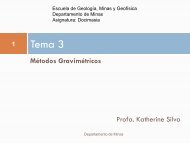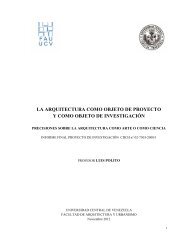Universidad de Carabobo Autoridades
vol23n32016
vol23n32016
You also want an ePaper? Increase the reach of your titles
YUMPU automatically turns print PDFs into web optimized ePapers that Google loves.
240 Damelys Zabala and Aurélie Wen<strong>de</strong>r / Revista Ingeniería UC , Vol. 23, No. 3, Diciembre 2016, 237-246<br />
7. Determine the ∆ρ s for the step change in the<br />
<strong>de</strong>nsity of the reference component ρ s . ( N p =<br />
500, [13]), with equation (11).<br />
∆ρ s = ρe s,L − ρe s,V<br />
N p<br />
(11)<br />
8. Solving the set of equations (7):<br />
F (i) = √ c i<br />
(<br />
µs<br />
(<br />
ρ1 , ρ 2 , ..ρ nc<br />
) − µ<br />
e<br />
s<br />
)<br />
− √ c s<br />
(<br />
µi<br />
(<br />
ρ1 , ρ 2 , ..ρ nc<br />
) − µ<br />
e<br />
i<br />
) = 0 (12)<br />
For the solution of the n c − 1 algebraic<br />
equations, (equation (12)), the initialization<br />
of the ρ i (is) is required at each k step<br />
(sequence from 8a to 8c).<br />
a) The matrix equation (14) is used for<br />
finding the first estimate of the n c − 1<br />
<strong>de</strong>rivatives dρ i<br />
dρ s<br />
n∑<br />
c −1 n∑<br />
c −1 {[ √ √ ] }<br />
ci ∂µ s cs ∂µ i dρ j<br />
−<br />
∂ρ<br />
i=1 j=1 j ∂ρ j dρ s<br />
√ √<br />
cs ∂µ i ci ∂µ s<br />
= −<br />
∂ρ s ∂ρ s<br />
(13)<br />
[ √ √ ]{ }<br />
ci ∂µ s cs ∂µ i dρ j<br />
−<br />
=<br />
∂ρ j ∂ρ j dρ s<br />
{ √ √ }<br />
cs ∂µ i ci ∂µ s<br />
−<br />
∂ρ s ∂ρ s<br />
(14)<br />
b) The n c <strong>de</strong>rivatives dµ i /dρ j required in<br />
equation 14 are evaluated numerically<br />
with δρ j = 1 × 10 −6 using the equation<br />
15 for the chemical potential of the<br />
component i in the mixture:<br />
µ i = µ res<br />
i<br />
Where, µ res<br />
i<br />
[ ( )]<br />
Pre f<br />
+ RT 1 − ln (15)<br />
ρ i RT<br />
= residual contribution of<br />
the chemical potential of i in the mixture,<br />
[kJ/kmol]<br />
c) The first estimation for the k step concentrations<br />
will be done with equations<br />
16 and 17:<br />
ρ k s = ρ k−1<br />
s + ∆ρ s (16)<br />
ρ k i = ρ k−1<br />
i +<br />
( ) dρi<br />
∆ρ s (17)<br />
dρ s<br />
d) With this first estimate for concentrations<br />
ρ i , the system of algebraic<br />
equations is solved by Newton-Raphson<br />
method, with N iterations (until in<br />
equation 19 the biggest of the |∆ρ i | ≤<br />
1 × 10 −7 ). (The <strong>de</strong>finitive concentrations<br />
for the k step are then achieved).<br />
⎛<br />
⎜⎝<br />
∂F(1) ∂F(1)<br />
∂ρ 1<br />
∂F(n c −1)<br />
∂ρ nc−1<br />
∂F(n c −1)<br />
∂ρ 1 ∂ρ nc−1<br />
⎛<br />
⎞⎟⎠ ⎜⎝<br />
∂F(1)<br />
∂ρ nc−1<br />
∂F(n c −1)<br />
∂ρ nc−1<br />
ρ k 1<br />
.<br />
ρ k n c −1<br />
⎞<br />
⎟⎠ =<br />
− ( F(1) . . . F(n c − 1) ) t<br />
⎛<br />
⎛<br />
∂F(1)<br />
∂ρ<br />
+ 1<br />
. . .<br />
ρ<br />
⎜⎝ ∂F(n c −1)<br />
∂ρ 1<br />
. . .<br />
⎞⎟⎠<br />
k−1 ⎞<br />
1<br />
ρ<br />
⎜⎝<br />
k−1<br />
2<br />
⎛ ∂F(1)<br />
∂ρ 1<br />
· · ·<br />
.<br />
. . .<br />
⎜⎝ ∂F(n c −1)<br />
∂ρ 1<br />
· · ·<br />
∂F(1)<br />
∂ρ nc−1<br />
.<br />
∂F(n c −1)<br />
∂ρ nc−1<br />
⎛ ⎞⎟⎠<br />
⎜⎝<br />
ρ k−1<br />
n c −1<br />
∆ρ 1<br />
..<br />
∆ρ nc −1<br />
= − ( F(1) ... F(n c − 1) ) t<br />
⎟⎠ (18)<br />
⎞<br />
⎟⎠<br />
(19)<br />
For the next k, the procedure from step<br />
8a) is repeated.<br />
9. Once the iterative process for getting “ρ i ” is<br />
finished, the <strong>de</strong>nsity profile for the reference<br />
component “ρ s (z)” must be verified and<br />
for doing that, the grand thermodynamic<br />
potential, Φ(ρ) is nee<strong>de</strong>d and it can be<br />
calculated by equation 20.<br />
∆Φ (ρ 1 , ρ 2 . . .ρ nc ) = Φ(ρ) − Φ e<br />
= A ∑nc<br />
V − (<br />
ρi µ e )<br />
i + P<br />
e<br />
i=1<br />
nc<br />
∑ (<br />
= a 0 − ρi µ e )<br />
i + P<br />
e<br />
i=1<br />
(20)<br />
Where Φ e = −P e , the equilibrium pressure,<br />
[Pa]<br />
A = Helmholtz energy [J]<br />
V = volume [m 3 ]<br />
a 0 = Helmholtz energy <strong>de</strong>nsity [J/m 3 ].<br />
The Helmholtz energy <strong>de</strong>nsity a 0<br />
calculated with equation (21).<br />
can be<br />
a 0 (ρ) = ρµ(ρ) − P(ρ) (21)<br />
Revista Ingeniería UC, ISSN: 1316–6832, Facultad <strong>de</strong> Ingeniería, <strong>Universidad</strong> <strong>de</strong> <strong>Carabobo</strong>.





